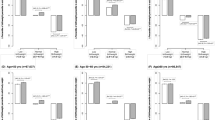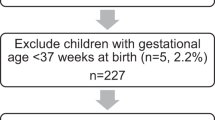Abstract
Background/objectives:
The role of smoking from the paternal line during the pre-conception period on grand-child’s overweight/obesity and associated underlying pathways are uncertain. We examined whether the smoking status from the paternal line was associated with the grand-child’s higher weight at birth, and overweight or obesity at 5 and 9 years of age. The grandparental smoking effect from the maternal line was also explored.
Subjects/methods:
Participants were fathers and grandparents and grand-children from the Lifeways Cross Generational Cohort (N = 1021 for the analysis at birth; N = 562 and N = 284 for the analysis at 5 and 9 years, respectively). Paternal and grandparental smoking was defined as smoking versus non-smoking. Children’s weight categories compared were high versus normal weight at birth, and overweight/obesity versus normal weight (based on BMI and waist circumference) at age of five and nine years. Logistic regression models were used to estimate the crude and adjusted associations.
Results:
After adjustment for several child and parental factors, at age five there was an association between paternal smoking and offspring’s overweight/obesity based on BMI (Adjusted Odds Ratio (AOR), and 95%CI: 1.76, 1.14–2.71, p-value: 0.010), most marked for boys (AOR: 2.05, 1.06–3.96, p-value: 0.032). These associations remained when confined to the children sample with biological fathers only (overall sample, AOR: 1.92, 1.22–3.02, p-value: 0.005; son, AOR: 2.09, 1.06–4.11, p-value: 0.033). At age 9, the paternal grandmothers’ smoking was positively associated with their grandchild’s overweight/obesity status based on waist circumference (AOR: 3.29, 1.29–8.37), and especially with that of her granddaughter (AOR: 3.44, 1.11–10.69). These associations remained when analysing only the children sample with biological fathers (overall sample, AOR: 3.22,1.25–8.29, p-value: 0.016; granddaughter, AOR: 3.55, 1.13–11.15, p-value: 0.030).
Conclusion:
The smoking habit from the paternal line is associated with grand-children’s adiposity measures during their early childhood, which might be epigenetically transmitted through male-germline cells.
This is a preview of subscription content, access via your institution
Access options
Subscribe to this journal
Receive 12 print issues and online access
$259.00 per year
only $21.58 per issue
Buy this article
- Purchase on Springer Link
- Instant access to full article PDF
Prices may be subject to local taxes which are calculated during checkout


Similar content being viewed by others
References
World Health Organization. Obesity and overweight. 2016. http://www.who.int/mediacentre/factsheets/fs311/en/. Accessed 1 Mar 2017.
Commission on Ending Childhood Obesity. Facts and figures on childhood obesity. 2016. http://www.who.int/end-childhood-obesity/facts/en/. Accessed 1 Mar 2017.
Reilly JJ, Kelly J. Long-term impact of overweight and obesity in childhood and adolescence on morbidity and premature mortality in adulthood: systematic review. Int J Obes. 2011;35:891–8.
Karnik S, Kanekar A. Childhood obesity: a global public health crisis. Int J Prev Med. 2012;3:1–7.
Sahoo K, Sahoo B, Choudhury AK, Sofi NY, Kumar R, Bhadoria AS. Childhood obesity: causes and consequences. J Fam Med Prim care. 2015;4:187–92.
Reitsma MB, Fullman N, Ng M, Salama JS, Abajobir A, Abate KH, et al. Smoking prevalence and attributable disease burden in 195 countries and territories, 1990–2015: a systematic analysis from the Global Burden of Disease Study 2015. Lancet. 2017;389:1885–906.
Rumrich IK, Viluksela M, Vähäkangas K, Gissler M, Surcel H-M, Hänninen O. Maternal smoking and the risk of cancer in early life—a meta-analysis. PLoS ONE. 2016;11:e0165040.
Zacharasiewicz A. Maternal smoking in pregnancy and its influence on childhood asthma. ERJ Open Res. 2016; 2: 42-2016-42–2016.
Banderali G, Martelli A, Landi M, Moretti F, Betti F, Radaelli G, et al. Short and long term health effects of parental tobacco smoking during pregnancy and lactation: a descriptive review. J Transl Med. 2015;13:327.
Rayfield S, Plugge E. Systematic review and meta-analysis of the association between maternal smoking in pregnancy and childhood overweight and obesity. J Epidemiol Community Health. 2017;71:162–73.
Møller SE, Ajslev TA, Andersen CS, Dalgård C, Sørensen TI. Risk of childhood overweight after exposure to tobacco smoking in prenatal and early postnatal life. PLoS ONE. 2014;9:e109184
Dior UP, Lawrence GM, Sitlani C, Enquobahrie D, Manor O, Siscovick DS, et al. Parental smoking during pregnancy and offspring cardio-metabolic risk factors at ages 17 and 32. Atherosclerosis. 2014;235:430–7.
Pembrey ME, Bygren LO, Kaati G, Edvinsson S, Northstone K, Sjostrom M, et al. Sex-specific, male-line transgenerational responses in humans. Eur J Hum Genet. 2006;14:159–66.
Dougan MM, Field AE, Rich-Edwards JW, Hankinson SE, Glynn RJ, Willett WC, et al. Is grand-parental smoking associated with adolescent obesity? A three-generational study. Int J Obes. 2016;40:531–7.
Pembrey ME. Male-line transgenerational responses in humans. Hum Fertil. 2010;13:268–71.
Bilano V, Gilmour S, Moffiet T, D’Espaignet ET, Stevens GA, Commar A, et al. Global trends and projections for tobacco use, 1990-2025: An analysis of smoking indicators from the WHO Comprehensive Information Systems for Tobacco Control. Lancet. 2015;385:966–76.
O’Mahony D, Fallon UB, Hannon F, Kloeckner K, Avalos G, Murphy AW, et al. The lifeways cross-generation study: design, recruitment and data management considerations. Ir Med J. 2007;100:3–6.
Kelleher CC, Fallon UB, Fitzsimon N, Bimpeh Y, Murphy G, Bury G, et al. The risk factor profile of grandparents. Ir Med J. 2007;100:15–9.
Kelleher CC, Viljoen K, Khalil H, Somerville R, O’Brien J, Shrivastava A, et al. Longitudinal follow-up of the relationship between dietary intake and growth and development in the Lifeways cross-generation cohort study 2001-2013. Proc Nutr Soc. 2014;73:118–31.
White IR, Royston P, Wood AM. Multiple imputation using chained equations: Issues and guidance for practice. Stat Med. 2011;30:377–99.
Azur MJ, Stuart EA, Frangakis C, Leaf PJ. Multiple Imputation by chained equations: What is it and how does? Int J Methods Psychiatr Res. 2012;20:40–9.
Graham JW, Olchowski AE, Gilreath TD. How many imputations are really needed? Some practical clarifications of multiple imputation theory. Prev Sci. 2007;8:206–13.
Murrin CM, Kelly GE, Tremblay RE, Kelleher CC, Whitaker R, Wright J, et al. Body mass index and height over three generations: evidence from the Lifeways cross-generational cohort study. BMC Public Health. 2012;12:81.
Cole TJ, Lobstein T. Extended international (IOTF) body mass index cut-offs for thinness, overweight and obesity. Pediatr Obes. 2012;7:284–94.
Cole TJ, Freeman JV, Preece MA. Body mass index reference curves for the UK, 1990. Arch Dis Child. 1995;73:25–9.
Marczylo EL, Amoako AA, Konje JC, Gant TW, Marczylo TH. Smoking induces differential miRNA expression in human spermatozoa: A potential transgenerational epigenetic concern? Epigenetics. 2012;7:432–9.
Stuppia L, Franzago M, Ballerini P, Gatta V, Antonucci I. Epigenetics and male reproduction: the consequences of paternal lifestyle on fertility, embryo development, and children lifetime health. Clin Epigenetics. 2015;7:120.
Rogers I. The influence of birthweight and intrauterine environment on adiposity and fat distribution in later life. Int J Obes Relat Metab Disord. 2003;27:755–77.
Murrin C, Heinen M, Kelleher C. Are dietary patterns of mothers during pregnancy related to children’s weight status? Evidence from the lifeways cross-generational cohort study. AIMS Public Heal. 2015;2:274–96.
Gregory J, Collins D, Davies P, Hughes J, PC C. National diet and nutrition survey: children aged 1.5–4.5 years. London: HMSO; 1995.
Wrieden WL, Longbottom PJ, Adamson AJ, Ogston SA, Payne A, Haleem MA, et al. Estimation of typical food portion sizes for children of different ages in Great Britain. Br J Nutr. 2008;99:1344–53.
Murrin C, Shrivastava A, Kelleher CC. Maternal macronutrient intake during pregnancy and 5 years postpartum and associations with child weight status aged five. Eur J Clin Nutr. 2013;67:670–9.
Galobardes B, Shaw M, Lawlor DA, Lynch JW, Davey Smith G. Indicators of socioeconomic position (part 1). J Epidemiol Community Heal. 2006;60:95–101.
Li J, Tsuprykov O, Yang X, Hocher B. Paternal programming of offspring cardiometabolic diseases in later life. J Hypertens. 2016;34:2111–26.
Pembrey M, Saffery R, Bygren LO. Human transgenerational responses to early-life experience: potential impact on development, health and biomedical research. J Med Genet. 2014;51:563–72.
Harris HR, Willett WC, Michels KB. Parental smoking during pregnancy and risk of overweight and obesity in the daughter. Int J Obes (Lond). 2013;37:1356–63.
Durmus B, Kruithof CJ, Gillman MH, Willemsen SP, Hofman A, Raat H, et al. Parental smoking during pregnancy, early growth, and risk of obesity in preschool children: the generation R study. Am J Clin Nutr. 2011;94:164–71.
Han TS, Hart CL, Haig C, Logue J, Upton MN, Watt GCM, et al. Contributions of maternal and paternal adiposity and smoking to adult offspring adiposity and cardiovascular risk: the midspan family study. BMJ Open. 2015;5:e007682.
Soubry A, Hoyo C, Jirtle RL, Murphy SK. A paternal environmental legacy: evidence for epigenetic inheritance through the male germ line. BioEssays. 2014;36:359–71.
DeMarini DM. Genotoxicity of tobacco smoke and tobacco smoke condensate: a review. Mutat Res—Rev Mutat Res. 2004;567:447–74.
Yauk CL, Berndt ML, Williams A, Rowan-Carroll A, Douglas GR, Stämpfli MR. Mainstream tobacco smoke causes paternal germ-line DNA mutation. Cancer Res. 2007;67:5103–6.
Marchetti F, Rowan-Carroll A, Williams A, Polyzos A, Berndt-Weis ML, Yauk CL. Sidestream tobacco smoke is a male germ cell mutagen. Proc Natl Acad Sci USA. 2011;108:12811–4.
Day J, Savani S, Krempley BD, Nguyen M, Kitlinska JB. Influence of paternal preconception exposures on their offspring: through epigenetics to phenotype. Am J Stem Cells. 2016;5:11–8.
Acknowledgements
We thank the participants of the Lifeways Cross-Generation Cohort Study, Ireland for their participation in each study stage. The Lifeways Cross-Generation Cohort study is founded by the Health Research Board of Ireland.
Author contributions
CML and CCK conceived and designed the present research study; CML analysed and interpreted the data, as well as wrote the first manuscript draft; CCK leads the Life ways Cross-Generation Study and assisted in the critical review and editing of the manuscript; JM as the Lifeways’ data manager was responsible for the raw data preparation and contributed to interpretation of results, revision and editing of the manuscript; CMM provided scientific advice relating to the data analysis and interpretation of results, particularly the dietary and nutritional aspects.
Author information
Authors and Affiliations
Consortia
Corresponding author
Ethics declarations
Conflict of interest
The authors declare that they have no conflict of interest.
Rights and permissions
About this article
Cite this article
Mejia-Lancheros, C., Mehegan, J., Murrin, C.M. et al. Smoking habit from the paternal line and grand-child’s overweight or obesity status in early childhood: prospective findings from the lifeways cross-generation cohort study. Int J Obes 42, 1853–1870 (2018). https://doi.org/10.1038/s41366-018-0039-8
Received:
Revised:
Accepted:
Published:
Issue Date:
DOI: https://doi.org/10.1038/s41366-018-0039-8
This article is cited by
-
Effects of paternal exposure to cigarette smoke on sperm DNA methylation and long-term metabolic syndrome in offspring
Epigenetics & Chromatin (2022)
-
Associations between a maternal healthy lifestyle score and adverse offspring birth outcomes and childhood obesity in the Lifeways Cross-Generation Cohort Study
International Journal of Obesity (2020)



